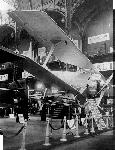
Flight, December 1924
The Paris Aero Show 1924
AVIONS HANRIOT
<...>
The most interesting machine on the Hanriot stand is undoubtedly the single-seater fighter biplane, type H.31, which is fitted with a 500 h.p. Salmson radial water-cooled engine. This machine, as well as the training monoplane, is shown in the accompanying photographs. The H.31 is a partly metallic biplane, somewhat similar in construction to the biplane shown in skeleton at the 1922 Paris show, but quite dissimilar in outward appearance. The wings have main spars of Duralumin box section (rectangular-section tubes) and composite ribs. The wing cellule is a single-bay, I-strut structure of normal type. The fuselage is constructed of Duralumin tubes forming longerons and triangulated struts. The resultant rectangular-section fuselage is built up to a streamline form by the addition of longitudinal stringers.
The 500 h.p. Salmson radial engine is almost entirely cowled-in, each cylinder having a fairing in front of it, as shown in one of the photographs. The Andre radiator is mounted under the belly of the fuselage, on the front chassis struts.
The main characteristics of the Hanriot H.31 are: Length overall, 7-16 m. (23 ft. 5 ins.); wing span, 11-5 m. (37 ft. 9 ins.); wing area, 33-5 sq. m. (361 sq. ft.). Weight empty, 1,144 kgs. (2,520 lbs.); useful load, 571 kgs. (1,255 lbs.); total loaded weight, 1,715 kgs. (3,775 lbs.). Power loading, 7-55 lbs./h.p.; wing loading, 10-45 lbs./ sq. ft. Maximum speed at ground level, 250 km./hr. (156 m.p.h.); speed at 8,000 m„ 240 km./hr. (150 m.p.h.). Climb to 5,000 m. (16,400 ft.) in 13 1/2 mins. Ceiling, 8,000 m. (26,200 ft.).
- Flight, December 1924
The Paris Aero Show 1924
Фотографии
-
Flight 1924-12 / Flight
Характерными отличиями прототипа истребителя Hanriot H.31 являлись фюзеляж, установленный между крыльями бипланной коробки, и индивидуальные обтекатели головок цилиндров.
ON THE HANRIOT STAND: The biplane single-seater fighter with Salmson engine. -
Air International 1982-02 / Fighter A to Z
The H.31 was a contender in the 1923 C1 programme, but offered an inferior performance to all other competitors.
- Фотографии

